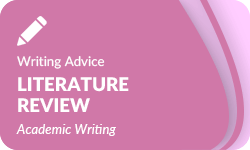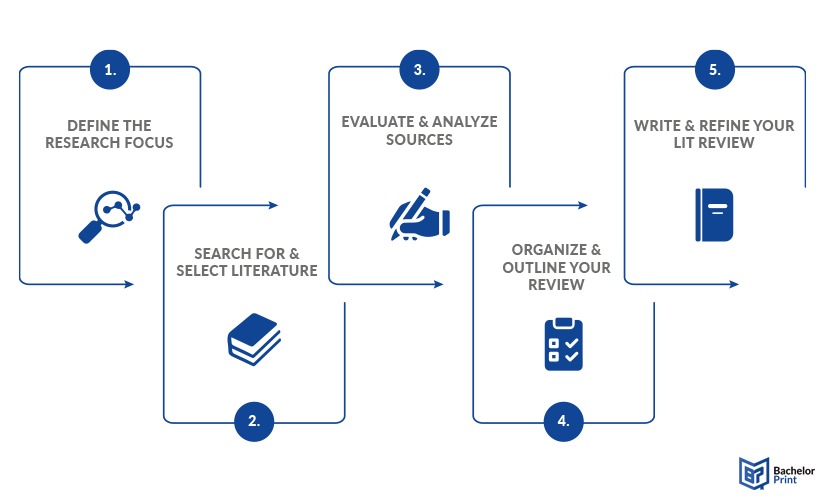
In the context of academic research, the literature review is a fundamental part of the overall methodology. It is an essential stage in the research process, involving the examination of academic sources related to a specific research question. By evaluating and synthesizing existing studies, the literature review deepens understanding of the topic, identifies gaps, and builds a solid foundation for new research.
Definition: Literature review
A literature review, or short lit review, is a comprehensive synthesis of existing research, scholarly articles, and academic publications relevant to a specific research topic or field of study. It is a core element of academic writing, serving as the foundation for a research paper, dissertation, or thesis. Positioned early in the work, it establishes the scholarly context, ensures originality, and guides the research paper.
A literature review can be:
- A standalone study summarizing the state of knowledge in a field.
- An integral section within a larger project
Primary functions
Its primary functions are to:
- Identify research gaps
- Support research design
- Provide academic context
- Establish a theoretical framework
- Avoid duplication of existing work
The 5 steps
To complete a literature review effectively, follow these five steps:
- Define your research focus
- Search for and select literature
- Evaluate and analyze sources
- Organize and outline your review
- Write and refine your lit review
The 5 C’s
To make your literature review more compelling, apply the 5 C’s approach when writing:
- Cite (give proper credit to all sources)
- Compare (identify common findings across studies)
- Contrast (point out conflicting results or interpretations)
- Critique (evaluate the quality and credibility of each study)
- Connect (show how the literature relates to your research focus)
Examples
Literature reviews can vary widely in their scope and depth, depending on their academic field and purpose. Each of the following examples provides a critical evaluation of the literature, noting areas where research is consistent or varies, and pointing out where further investigation is needed.
Writing a literature review
Writing a literature review is a key stage in any academic paper. It shows where your work fits in the existing body of knowledge and helps you build a strong foundation for your research. Follow these five steps to create a well-structured, insightful review.

Step 1: Define the research focus
A clear research focus keeps your review relevant and prevents information overload. Start by defining your research question and narrowing your topic. This ensures that you gather the right sources and analyze them in a focused way.
While a literature review does not have a traditional thesis statement like in other research papers, it should still have a guiding statement that indicates the focus of your review. This guiding statement will help orient the reader and define the key themes or trends you will address.
Step 2: Search for & select literature
Now that you’ve defined your research question, it’s time to gather relevant, high-quality sources. Selecting the right literature is crucial to ensure your review is comprehensive and supports your research question.
Start by searching in reputable academic databases, which provide access to peer-reviewed journals, books, and conference papers. Below are some recommended databases for different fields of study.
Recommended databases:
- JSTOR
- EBSCO
- ProQuest
- Google Scholar
- Your university’s library
- PubMed (health, medicine, life sciences)
- PsycINFO (psychology, behavioral sciences)
- IEEE Xplore (electric engineering, computer science)
- ScienceDirect (science, technology, medical research)
- ERIC (teaching methods, pedagogy, educational research)
Once you’ve chosen a database, use specific keywords related to your research topic to refine your search. This ensures you find sources that are most relevant to your review.
As you search, keep the following tips in mind:
- Read abstracts first to check relevance.
- Use Boolean operators to refine searches.
- Include foundational studies and recent research for balance.
- Review the bibliography of relevant papers for additional sources.
Note: By following these steps, you will ensure that your literature review is built on strong, credible sources that directly support your research focus.
Step 3: Evaluate & analyze sources
Assess the credibility and relevance of each source by checking:
- Peer-review status
- Publication date (to ensure currency)
- Research methodology and sample size
- Author authority and institutional affiliation
➜ Analysis goal: Identify patterns, debates, and research gaps.
Once you’ve assessed each source, it helps to record your findings in a structured format. Download our free templates below to organize your literature review efficiently.
Step 4: Organize & outline your review
Choose the structure that best suits your topic.
The chronological method organizes sources by their publication date, providing a timeline of how the research topic has developed over the years. It’s useful for showing the progression of ideas, trends, or changes in theories and methodologies. An example can be found above.
This organizational method organizes sources by the methods used, such as qualitative vs. quantitative research or case studies vs. experiments. It’s ideal for comparing studies that use different approaches to answer similar research questions, helping to identify methodological strengths, weaknesses, or research biases. An example can be found above.
In a thematic review, literature is grouped based on recurring central themes or topics. This helps to compare different viewpoints and analyze how different studies address the same themes. An example can be found above.
Literature is categorized based on different theoretical perspectives or models used in the studies. This organizational method is beneficial when comparing how various are applied to the same research question and which provide the most robust explanations. An example can be found above.
As you sort sources into categories, start writing brief notes that can later be integrated into your literature review. Keep full citation details for every source to prevent plagiarism, and consider creating an annotated bibliography with summaries and short analyses for each entry. This keeps your work organized and saves time during the writing phase.
Step 5: Write & refine your lit review
When writing your literature review, structure it into three main sections: introduction, body, and conclusion.
Start by briefly presenting the key topic(s) and explaining the purpose of the literature review. Include your research question or objective, and provide an overview of the organization of your review.
Note: If your literature review is part of a dissertation or thesis, restate your main research question and briefly summarize the academic context. You can point out why the topic is relevant now or highlight a gap. If it’s a standalone literature review, this part can be longer.
Organize this literature review section using the approach you’ve chosen. Here, the discussion of sources takes place. For each section, introduce the theme or category, summarize and synthesize relevant studies, compare findings, analyze and interpret how the sources relate to one another, and critically evaluate your sources. Use subheadings, transition words, and topic sentences to make the structure clear and ensure smooth connections between sections.
Note: The body should contain the presentation and discussion of sources, using an approach that aligns with the content and effectively conveys the findings within the review.
Summarize the main insights from the literature review and reiterate the key themes and debates you found. Highlight any research gaps or unresolved issues that emerged from your review. Finally, explain how your own research will contribute to addressing these gaps or building on existing knowledge.
Note: Show how your research fills gaps and adds new knowledge, or explain how you’ve used existing theories and methods to create a foundation for your study. If it’s a standalone literature review, this part can be longer.
Below, we provide an outline for our exemplary research question:
Tips & strategies
Writing a literature review can feel overwhelming, but using the right strategies can make the process smoother and more effective. The following tips will help you stay organized, critically evaluate sources, and craft a well-structured review that adds value to your research.
1️⃣ Start with a clear focus
Define your research question early to guide your search.
2️⃣ Use Boolean operators
Combine keywords with AND, OR, NOT to refine results.
3️⃣ Stay organized
Use reference managers like Zotero to track citations.
4️⃣ Take notes as you read
Summarize key points for quick reference during writing.
5️⃣ Analyze critically
Compare the strengths, weaknesses, and methodologies.
6️⃣ Group by themes
Organize findings into relevant categories or sections.
7️⃣ Be selective
Include only sources that directly support your research focus.
8️⃣ Balance perspectives
Present both supporting and opposing viewpoints.
9️⃣ Revise thoroughly
Check for clarity, logical flow, and alignment with your aims.
Using AI tools in the process
AI tools, such as language models and research assistants, can support parts of the literature review process by helping generate keyword lists, summarizing articles, or suggesting possible thematic groupings.
When used responsibly, they can save time and improve organization. However, AI cannot replace critical reading and analysis. Researchers must verify the accuracy of AI-generated content, check original sources, and ensure that interpretations are their own. Most universities require that all sources be cited directly and that AI be acknowledged when used in the research process.
Checklist
A checklist can be a valuable tool to ensure your literature review is comprehensive, well-organized, and meets academic standards. Use this checklist as a guide to track your progress, from selecting sources to finalizing your review, making sure you cover all essential steps along the way.
FAQs
A literature review is a summary and critical evaluation of existing research on a specific topic. It identifies key themes, debates, and gaps, providing context for new research.
To demonstrate your research capabilities and show that you can critically analyze and synthesize existing knowledge in your field.
The three main parts are the introduction (topic, purpose, scope), the body (organized synthesis of sources), and the conclusion (summary, gaps, relevance to your research).
The five C’s are:
- Cite
- Compare
- Contrast
- Critique
- Connect
A literature review summarizes and analyzes existing studies, while a research paper presents original findings based on your own data and analysis.